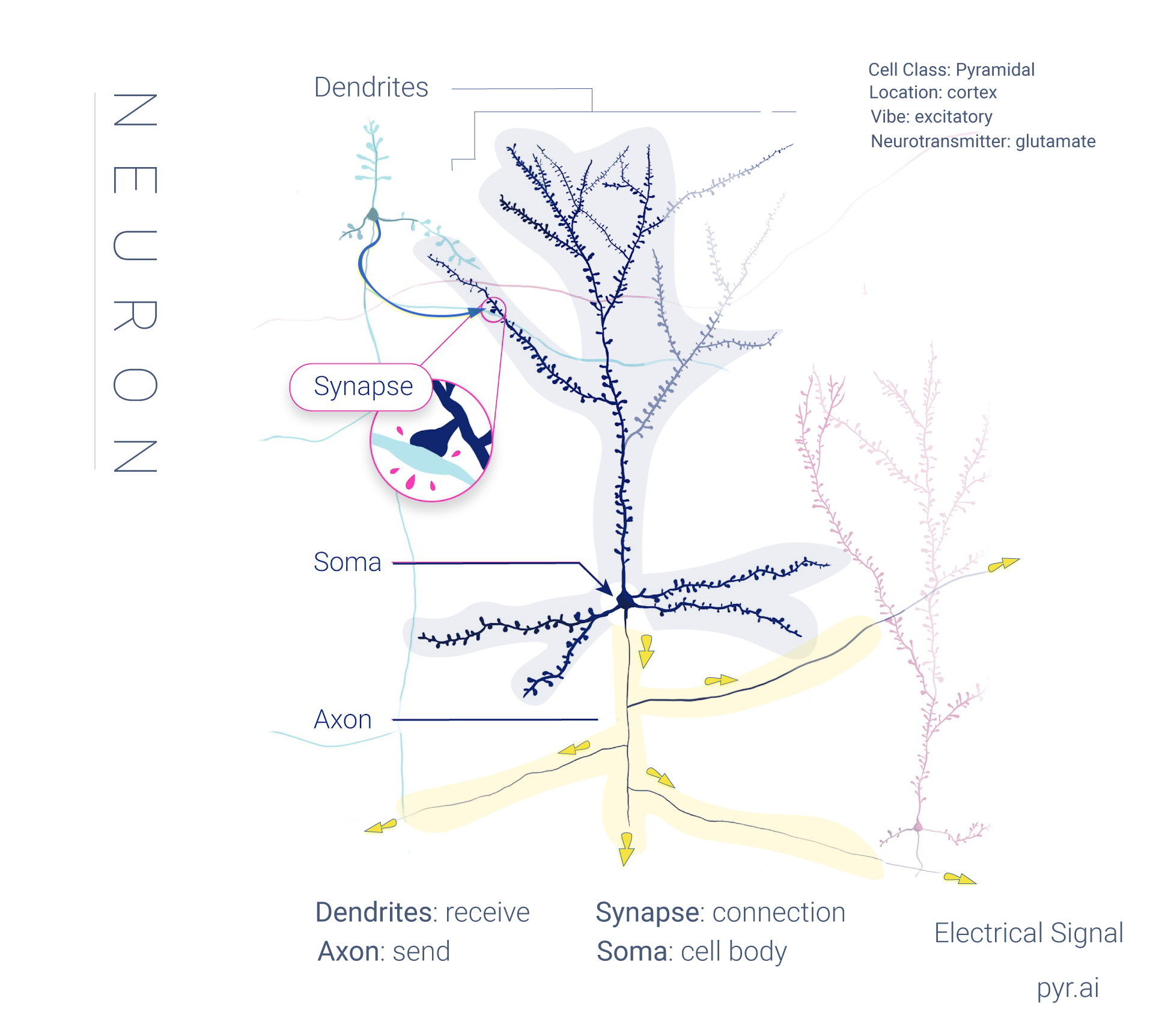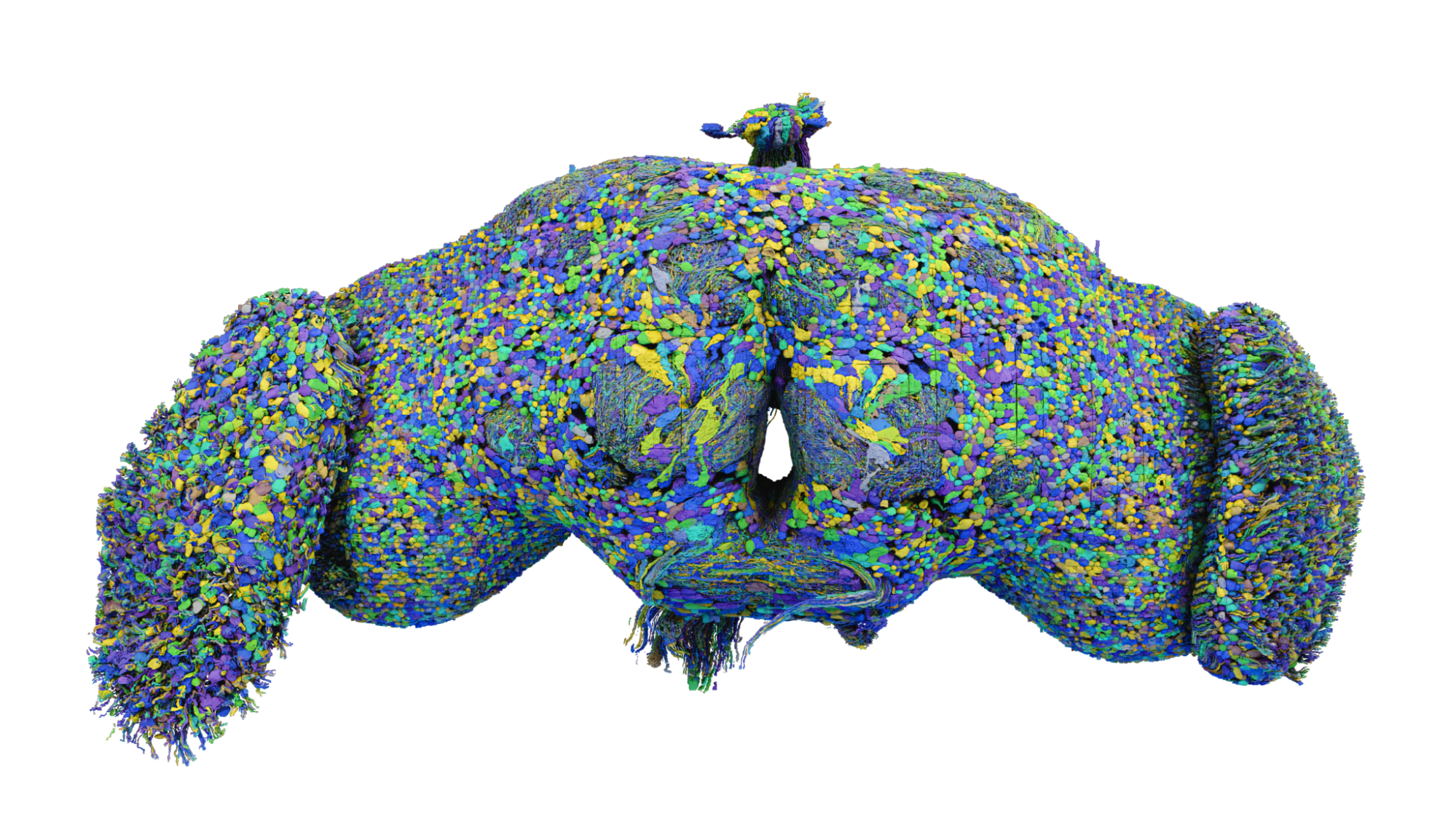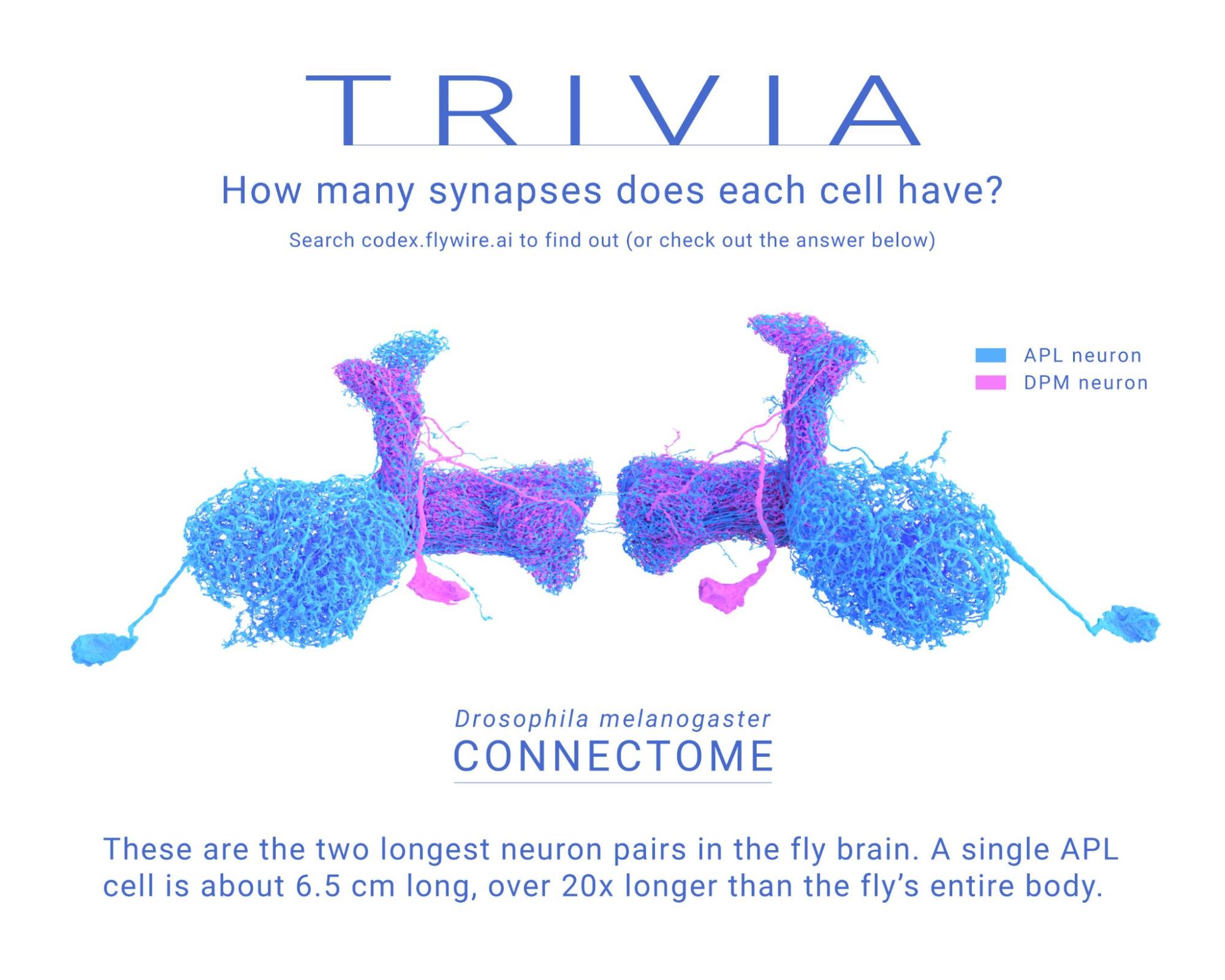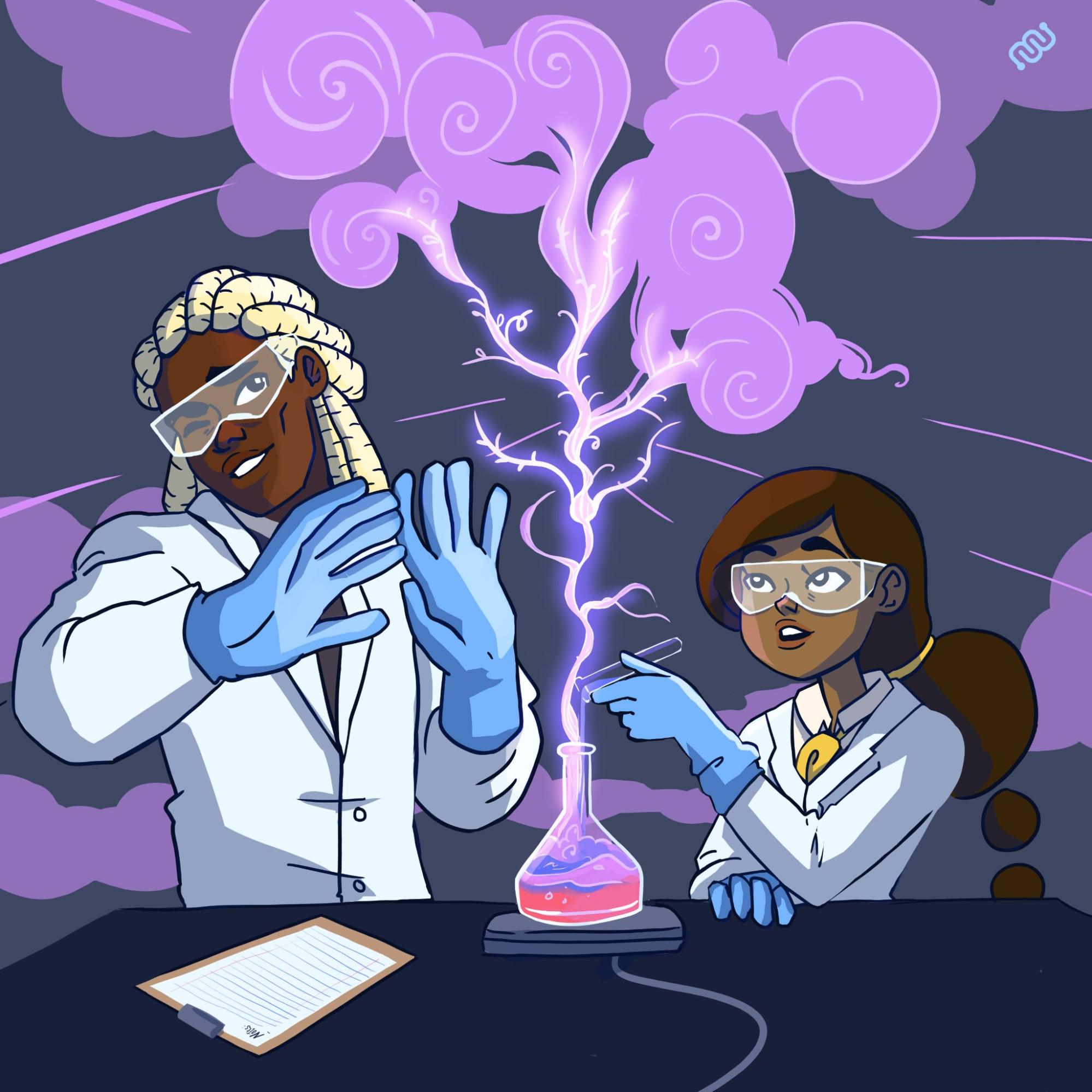
Welcome to the FlyWire Academy!
These materials are designed to be used by high school and college teachers, instructors, or scientists doing educational outreach.
Here you will find video content, interactive lessons, and graphics which give students the opportunity to learn key concepts in neuroscience while digitally exploring cutting-edge scientific data and examining real neurons in the brain of a fruit fly--the largest brain ever mapped at synapse resolution! For information on the research, check out the publication “Neuronal wiring diagram of an adult brain.”
We provide a combination of introductory videos (so instructors do not need to have neuroscience expertise to use these materials in class), “dry-lab” exercises which guide students through an exploration of the brain, and optional programming exercises. We have provided complete lesson plans at both high school and college levels.

We are also eager for the FlyWire scientific community to contribute to this educational resource. If you would like to share any teaching or outreach materials you have developed using FlyWire and Codex, you can upload them here. You can also browse existing materials contributed by other scientists.
FlyWire for High School Classrooms
This package of materials is designed primarily for students taking advanced high school biology courses (such as AP Biology, AP Psychology, IB Biology, Biotechnology, or Neuroscience), but can also be used in introductory or honors biology courses. Instructors can choose to follow the recommended lesson structure over either 1 or 2 class days, or use these materials flexibly as part of their own lessons.

We recommend starting the lesson with the introductory videos, which provide students with essential background information about connectomics and explain how this specific dataset was created. We also provide a tutorial on how to use the Connectome Data Explorer website Codex. The bulk of the lesson will then be an interactive “dry lab,” in which the worksheets guide students through an exploration of the fly brain. Students can complete these worksheets in class with laptops (students will require a Google account to access Codex).
We encourage instructors to have students work on these exercises in teams, so they can discuss ideas together. Instructors may also choose to hold class discussions at the end of the lesson. Each worksheet should take between 20-30 minutes to complete. The worksheets are intended to be completed in order, building on earlier concepts. Instructors may also choose to use some of the worksheets as homework assignments.

Resources
- Introductory Videos:
- Video 1: What is a connectome?
- Video 2: The fruit fly in neuroscience
- Video 3: Codex tutorial
- Additional videos available on FlyWire Princeton YouTube. Also, check out Dr. Sebastian Seung's TED talk here!
-
Exercises:
- Worksheet 1: Neuron anatomy, neurotransmitters, and the whole brain
- Worksheet 2: Nerves, brain regions, and connectivity
- Worksheet 3: Circuits, pathways, and vision
- Answer keys are available to instructors: please contact us at flywire@princeton.edu.
Relevant AP/IB Units
-
AP Biology:
- Cell Structure and Function
- Cell Communication
- Biotechnology
-
AP Psychology:
- Biological Bases of Psychology
-
IB Biology:
- Neurobiology and behavior
- Biotechnology and bioinformatics
Learning Objectives
- How diverse are the neurons which make up a brain?
- How do neurons communicate with each other?
- How do brain regions differ from one another?
- How do neurons form circuits and pathways?
FlyWire for College Classrooms
This package of materials is designed for Introduction to Neuroscience or Biology courses at the college level, but may also be employed in upper-division courses (perhaps as a jumping off point for an open-ended project using FlyWire data). Instructors can choose to follow the recommended lesson structure over 1-2 class days, or use these materials flexibly as part of their own lessons. In large, lecture-based courses, the connectome data can be introduced in lecture and the exercises can be completed during section or as group assignments.
We recommend starting the lesson with the introductory videos, which provide students with essential background information about connectomics and explain how this specific dataset was created. We also provide a tutorial on how to use the Codex website. The bulk of the lesson will then be an interactive “dry lab,” in which the worksheets guide students through an exploration of the fly brain. Students can complete these worksheets in class with laptops (students will require a Google account to access Codex). We encourage instructors to have students work on these exercises in teams, so they can discuss ideas together. Instructors may also choose to hold class discussions at the end of the lesson. We expect each college worksheet to take between 30-45 minutes to complete. The worksheets are intended to be completed in order, building on earlier concepts. Instructors may also choose to use some of the worksheets as homework assignments.
Additionally, coding exercises in which students use Python to programmatically analyze the connectome data are currently in development, and will be coming soon!
Resources
- Introductory Videos:
- Video 1: What is a connectome?
- Video 2: The fruit fly in neuroscience
- Video 3: Codex tutorial
- Additional videos available on FlyWire Princeton YouTube. Also, check out Dr. Sebastian Seung's TED talk here!
-
Exercises:
- Worksheet 1: Neurons, brain regions, and nerves
- Worksheet 2: Network connectivity
- Worksheet 3: Circuits
- Answer keys are available to instructors: please contact us at flywire@princeton.edu.
- Programming Exercises (coming soon)
-
Additional materials
- Group project prompts (coming soon)
Learning Objectives
- How diverse are the neurons which make up a brain, both in terms of morphology and connectivity?
- How do brain regions differ from and connect with each other?
- How common is recurrence in brains?
- How do large and/or highly connected neurons support circuit function?
- How does sensory information propagate through brain circuits?

Trivia answer ▼
FlyWire for Science Outreach
If you’d like to share any teaching or outreach materials you have developed using FlyWire and Codex, you can upload them here. Please include a readme containing your name and affiliation, notes about the subjects covered and the grade level the materials are intended for.
You can browse materials generated by the community here!
The FlyWire Academy Team
Albert Lin
Albert is currently a CPBF Fellow at Princeton University, working with Mala Murthy on whole-brain functional imaging and connectome analysis in the fruit fly. Albert received his A.B. in Physics with a certificate in Biophysics from Princeton University, and his Ph.D. in Physics from Harvard University. In his graduate work in Dr. Aravinthan Samuel’s lab, he developed methods for recording and analyzing ensemble-level and whole-brain neural activity in the nematode C. elegans.
Amy Sterling
Amy is the Crowdsourcing Manager of FlyWire and the Executive Director of the brain mapping game Eyewire. She is passionate about design and community building. Her work has helped bring interactive data tools and novel visualizations to the world of neuroscience. She created the world’s first neuron VR experience, helped put neurons in Times Square NYC, and continually strives to inspire curiosity and participation in cutting-edge brain research.
Arie Matsliah
Arie is a research scientist at Princeton Neuroscience Institute. He received his Ph.D. in computer science from the Technion - Israel Institute of Technology. In addition to developing the FlyWire Codex, Arie's work primarily focuses on computational methods for connectomics, aiding in the analysis and mapping of neural circuits.
Questions? Contact flywire@princeton.edu
